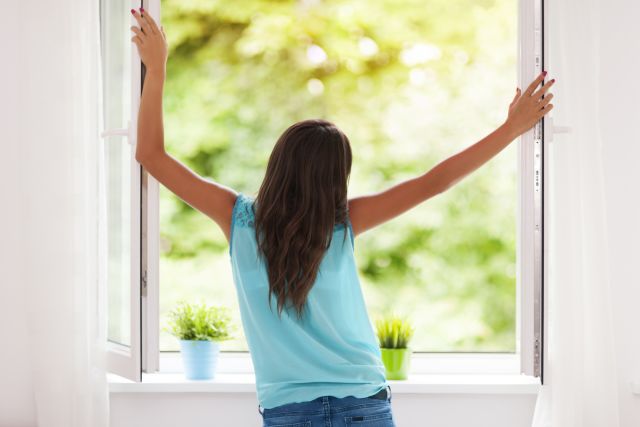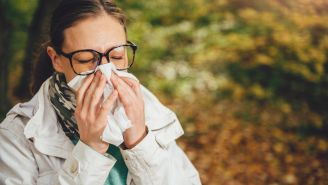For many in the United States, the warmer, longer days of spring can’t come soon enough. But for tens of millions of people, early spring marks the beginning of yet another allergy season—and the sniffling, sneezing, itching, wheezing, and overall frustration that comes with it.
In the U.S., those with spring allergies may contend with these irritating symptoms as early as February and they may linger until early summer. The main culprits triggering this misery are tree, grass, and weed pollen (and ragweed for fall allergies). These yellowish powders fertilize plants and are spread by wind, insects, and birds.
A rainy spring can help plants—and mold—grow more quickly, causing allergy symptoms to linger for months. Milder winter temperatures can also cause plants to pollinate early, which means that spring allergy season is starting earlier and lasting longer.
And the problem is likely getting worse, not better. The amount of pollen in the air rose 21 percent between 1990 and 2018, according to a 2020 study published in the journal PNAS. Researchers also found the length of pollen season increased by 10 days.
If you’re one of the millions affected by seasonal allergies, it’s important to make sure you’re doing all that you can to keep your symptoms under control. This includes being aware of all the ways you may be unintentionally making your allergies even worse.
Avoid these missteps, which could trigger a flare-up of your symptoms.
Using the wrong air filter
Air filters can help purify the air and get rid of pollen in your home or office, but only if you choose the correct one.
There are two types of air cleaners: portable air cleaners and central furnace, or HVAC, filters. Portable air cleaners filter the air in one room, while central furnace filters treat air throughout an entire home. Inexpensive central furnace and air conditioning filters, however, don’t always do the trick. In fact, not replacing them often enough could make your allergies worse.
If you have a forced air heating or cooling system in your home, consider using high-efficiency filters and stick to a regular maintenance schedule. Placing a portable high-efficiency particulate air (HEPA) filter in your bedroom or using a dehumidifier can also help.
Letting fresh air in
Spring air can be refreshing and invigorating, particularly after a long winter. But if you have spring allergies and open your windows, you’re not doing yourself any favors.
Open windows allow pollen-laden breezes to flow into your home. The pollen can then settle into your carpeting, furniture, bedding, and upholstery, triggering pesky symptoms. During spring allergy season, you can avoid flare-ups by opting for an air conditioner on hot days and keeping your house and car windows closed.
Hanging clothes outside to dry
Air-drying your wet sheets, towels, and other laundry outside might be tempting. It is, after all, less expensive and more energy efficient than using a dryer. But your laundry will likely also be coated in pollen after drying in the afternoon breeze since pollen easily clings to fabric. And climbing into a bed with these "spring fresh" sheets or wrapping yourself in a towel that was hung outside to dry could make your allergy symptoms worse.
Skipping your evening shower
After a long day, the last thing you may want to do before falling into your bed is take a shower and shampoo your hair. But you should. Not taking a shower before you go to sleep allows the pollen that’s accumulated on your body, hair, and clothing to get into bed with you. This could not only make your symptoms flare up, but also prevent you from getting enough sleep. Make nightly showers part of your routine to remove pollen before bedtime.
Letting furry friends sleep in your bed
Sure, you love your pets, and snuggling up with them in bed can be cozy. But this tempting habit could be making your allergies worse. Pollen can settle into your pets’ fur, triggering symptoms. Keep your pets out of your bed, or better yet, keep them out of your bedroom altogether.
If your symptoms are particularly bothersome, restricting pets to certain rooms so they can’t wander can help reduce the spread of potential allergens.
These steps may be helpful but they’re not foolproof. Allergens can still spread beyond the rooms that pets occupy. If you suffer from seasonal allergies and have pets, it’s also a good idea to bathe or groom them at least once a week.
Spending time outside on the wrong days
Heading outside when pollen counts are high is one way to trigger seasonal allergy symptoms. So, try to stay indoors on windy days and reserve your outside time until after it rains. Rain clears pollen, which helps to keep allergy symptoms at bay. If you have to do outdoor chores on a day with high pollen counts, always wear a NIOSH-rated 95 filter mask and take appropriate medication beforehand.
Putting off spring cleaning
The dust in your home may contain pollen as well as a cocktail of year-round allergens—pet hair and dander, mold and dust mites—that could lead to an allergy flare-up. Taking the time to clean can help you enjoy spring rather than suffer through it.
If you have seasonal allergies, having someone else (who doesn’t have allergies) clean your home can help you avoid a flare-up. If that’s not an option, be sure to wear a dust mask while you clean. It’s also a good idea to use a vacuum cleaner that has a HEPA filter and wash your bedding weekly.
Starting your medications too late
Waiting until you develop allergy symptoms to see an allergist or other healthcare provider (HCP) is too late. You can stay several steps ahead of allergy season by taking your medication before it gets underway. Talk to your HCP about what treatment is appropriate for you and develop a plan of action to help ensure you avoid unnecessary flare-ups. And be sure to see your allergist or HCP if your treatments aren’t working well enough and need to be adjusted.







